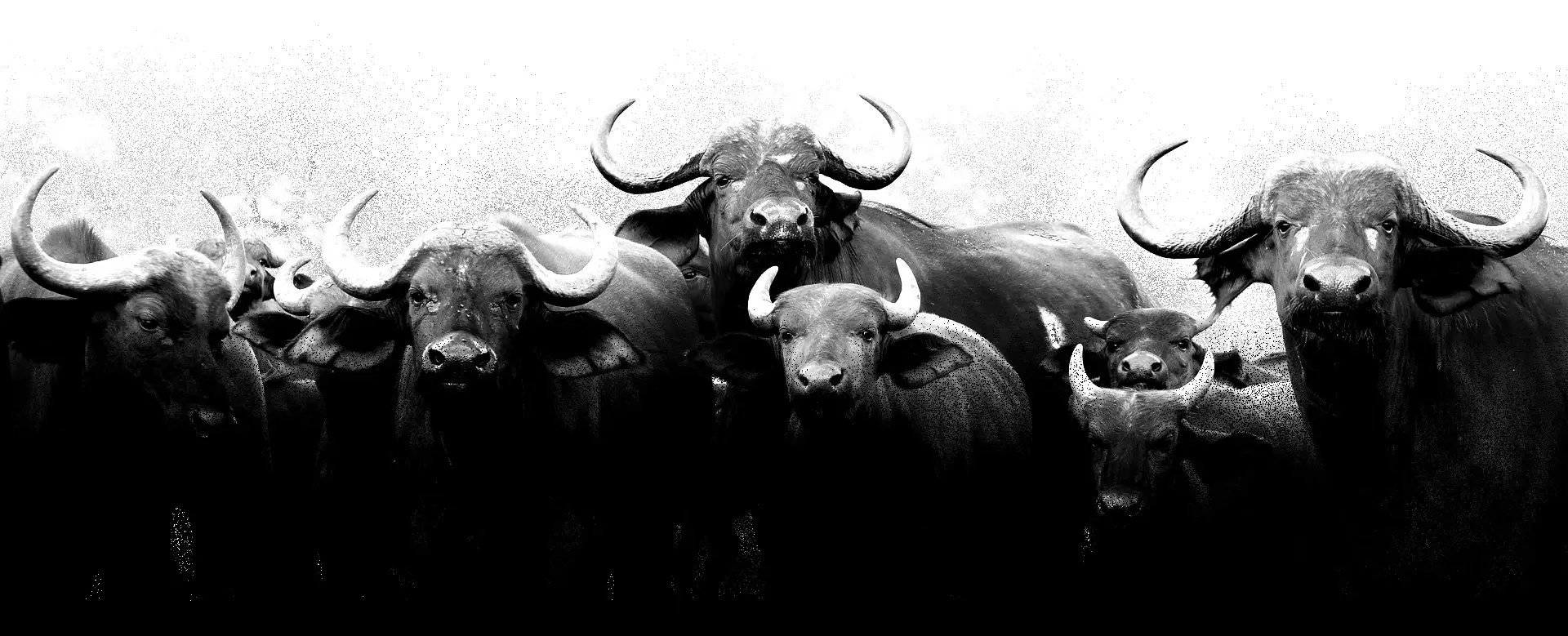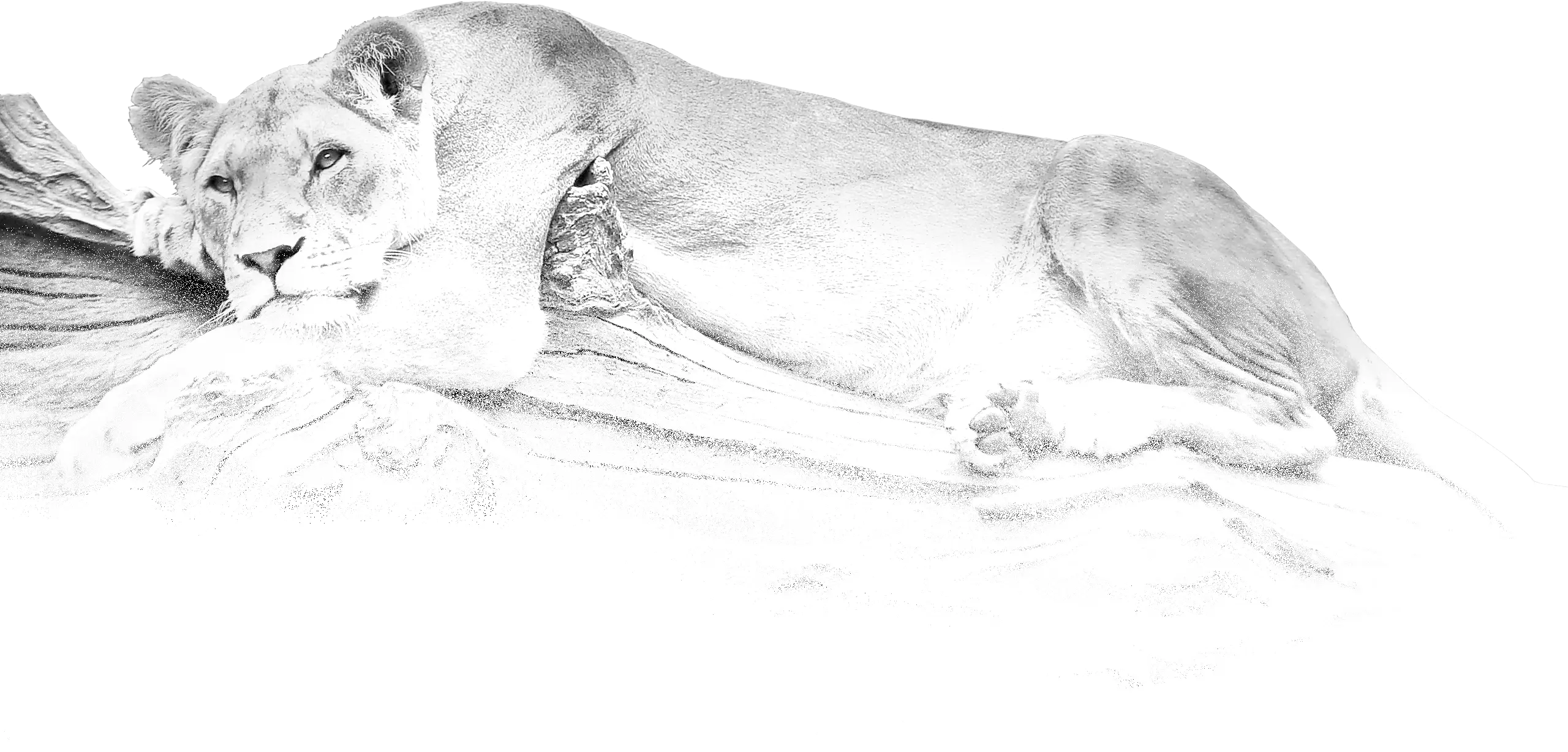
(Felidae)
Cats
Котові
With the exception of Antarctica, Australia, New Zealand, Madagascar, Japan, and most oceanic islands, native populations of cats are found worldwide, and one species, domestic cats, have been introduced nearly everywhere humans currently exist. Although some authorities recognize only a few genera, most accounts of Felidae recognize 18 genera and 36 species. With the exception of the largest cats, most are adept climbers, and many are skilled swimmers. Most felids are solitary. Often, felids are separated into two distinct subgroups, large cats and small cats. Generally, small cats are those that, due to a hardening of the hyoid bone, have an inability to roar. Felidae consists of 2 subfamilies, Pantherinae (e.g., lions and tigers) and Felinae (e.g., bobcats, pumas, and cheetahs).
Felids are perhaps the most morphologically specialized hunters of all carnivores, often taking prey as large as themselves and occasionally taking prey several times their own size. Unlike other carnivores, felids rely almost exclusively on prey that they have killed themselves. They are agile hunters, hunting mostly at night, with diets consisting of fresh meat or carrion. Felids are found in all terrestrial habitats except treeless tundra and polar ice caps.
Habitat
Cats are found in all terrestrial habitats except treeless tundra and polar ice regions. Most species are habitat generalists and can be found in a wide range of environments. However, few have adapted to a limited range of habitats. For example, optimal habitat for sand cats (Felis margarita) consists of sandy and stony deserts. Domestic and feral cats (F. catus) are ubiquitous globally and are especially pervasive in urban and suburban areas.
Physical Description
All felids bear a strong resemblance to one another. Unlike members of the family Canidae, felids have a short rostrum and tooth row, which increases bite force. Loss or reduction of cheek teeth is particularly apparent in felids, which have a typical dental formula of 3/3, 1/1, 3/2, 1/1 = 30. In most species, the upper premolar is significantly reduced and in Lynx, has been completely lost. Felids have well developed carnassials. Their cheek teeth are secodont and are specialized for shearing. Felid canines tend to be long and conical and are ideal for puncturing prey tissues with minimal force. Besides having a short rostrum, felids also have large bullae that are divided by a septum; no alisphenoid canal, and paroccipital processes flattened against the bullae. Felids also have a vestigial or absent baculum and retractable claws. Distal segments of digits in the relaxed position are pulled back and up into a sheath by an elastic segment, which prevents claws from becoming blunt. Cheetahs are the exception as they cannot retract their claws and, when attacking prey, they tend to run into them so that they fall, much like canids. Cats have five toes on their forefeet and four on their hindfeet. They are digitigrade, and their metapodials are moderately long but never fused.
Felids range in body mass from 2 kg in black-footed cats (Felis negripes) to 300 kg in tigers (Panthera tigris), and exhibit sexual dimorphism, with males being larger and more muscular than females. In some species, such as lions (Panthera leo), males may also have ornamentation that is used to attract potential mates. Throughout their range, felid coats are longest where temperatures tend to be coldest (e.g., snow leopards). Felids exhibit a wide range of colors, from black to orange to white, and many species have cryptically colored coats containing rosettes, spots, and stripes that help camouflage them while hunting for prey. While melanistic variants (solid black) are common in many species, completely white individuals tend to be rare. A great deal of color variation can occur within individual species and newborns tend to have different coloration than adults. For example, adult cougars (Puma concolor) rarely have spots while kittens almost always have spots. In general, the ventral surface of felids tends to be pale while the face, tail, and back of the ears often have black or white markings.
Felids have a number of morphological adaptations that have allowed them to become the most adept hunters in the order Carnivora. They have digitigrade posture that results in a rapid stride rate and powerful forelimbs that help them capture and retain large prey. Often, felids are cryptically colored, which helps camouflage them while hunting. In addition, most felids have large eyes and exceptional vision. In nocturnal species, the tapetum lucidum helps intensify limited light. Many species also have large semi-rotating ears. Finally, the felid tongue has a sandpaper-like texture due to posteriorly directed papillae on its dorsal surface, which are thought to help retain food in the mouth and remove tissue from the bones of prey.
Reproduction
Felids are most often classified as polygynous but can exhibit polygynandrous behavior as well. Estrous lasts from 1 to 21 days and females may have multiple estrous cycles until they become pregnant. Females advertise estrus to potential mates through vocalizations, scent marking, and restlessness. As with most polygynous species, males compete for access to mates via displays and fighting, and successful males court mates through vocalizations and direct physical contact (e.g., rubbing on the female). During courtship, successful males may also approach receptive females with their head lowered. While the act of copulation lasts less than a minute, multiple copulations can occur over a period of several days, which may help induce ovulation. After several days, males may leave in order to find additional estrous females, in which case another male takes his place.
In felids, male territories often encompass those of multiple females (for an exception Panther leo) and males mate with females that reside within his territory. Most conspecific interactions occur during mating season or as a result of territorial disputes among rival males. Indirect interactions via scent markings or vocalizations help reduce the number of fatal interactions.
The act of copulation is aggressive and brief and may be repeated multiple times an hour for several days. Repeated copulation is thought to induce ovulation in females. Most species are polygynous and polyestrous, with estrous cycles lasting from from 1 to 3 days. Most felids are non-seasonal breeders, but in areas of extreme climatic or prey variability, parturition occurs during the most favorable times of the year. Small-bodied cats tend to have 3 litters per year, while large cats average 1 litter every 18 months. The interval between birthing events may depend on maturation rates of young, body size, food availability, or recent loss of litter. For example, if a female loses her litter, she can come into estrus within a few weeks. Although most litters contain 2 to 4 cubs, females can give birth to as many as 8 cubs in a litter. Gestation lasts from 2 months in small cats to 3 months in lions and tigers.
Felid cubs are born altricial, as newborns are often blind and deaf, rendering them defenseless. Mothers often hide newborns in dens, rock crevices, or tree hollows until they are mobile. Cubs remain with their mother until they can hunt on their own. Weaning begins at the introduction of solid food and ranges in length from 28 days (domestic cats) to 100 days (lions and tigers). Felids reach sexual maturity in less than a year for small cats and up to 2 years for large cats. Typically, cats do not produce their first litter until they have established a home range, which usually does not occur until they are 3 or 4 years of age. Although age of independence is highly variable, many species become independent around 18 months of age. Unlike most felids, lions are very social and females take turns nursing young born to other pride members (i.e., communal nursing) while absent mothers are hunting for food.
With the exception of lions, females are the sole caretakers of young felids. Mothers hide their cubs in dens, rock crevices, or tree hollows while they are away hunting and young hide until she returns. Weaning begins at the introduction of solid food, around 28 days in domestic cats (Felis catus) and 100 days in lions. Females teach cubs how to stalk, pounce, and kill. Weaning is complete when cubs can eat meat and help hunt for prey. Juvenile felids spend a majority of their time “role playing,” which helps develop important hunting skills. Juveniles are independent once they become competent hunters, though they may remain in their mother’s territory for up to a year before they establish their own. Most felids do not begin reproducing until they have their own territories. Although male lions use infanticide to eliminate unrelated young during pride takeover events, they also provide a significant degree of parental care to their own offspring, protecting cubs while they feed and allowing mothers to rest.
Lifespan/Longevity
Although many cats do not live beyond their first birthday, felid lifespan ranges from 15 to 30 years old. In the wild, juvenile deaths are normally due to predation. In captivity, however, juvenile deaths are often due to stillbirths, cannibalism, maternal neglect, hypothermia, and congenital disorder.
Behavior
With the exception of lions (Panthera leo), which form prides, felids are solitary animals that only come together to mate. They tend to hunt at night (for an exception Acinonyx jubatus) and, although most are primarily nocturnal, activity levels peak during dusk and dawn. Most cats are exceptional climbers and some species are skilled swimmers. When conspecifics meet, their tail posture, position of the ears, and exposure of teeth reveals their level of tolerance. Scent marking, rubbing, and scratching trees are used to mark territorial boundaries and communicate dominance and fertility.
Most felids stalk, crouch, wait, and pounce while hunting prey. They avoid long chases typical of canids and are considered ambush predators. Small prey are killed with a specialized bite to the base of the skull, which severs the spinal cord. Large prey are typically killed by suffocation. Prior to eating, some species drag carcass by the nape to a secluded location. Most small cats feed by crouching over their prey without using their paws, whereas large cats eat while lying down. Felids are instinctive hunters and, if given the opportunity, they will kill more prey than they can eat.
Communication and Perception
Felids have acute senses of smell, hearing, and sight. In addition to the tapetum lucidum, a layer of reflective tissue in the eye of many vertebrates, felids have a modified pupil that allows for excellent vision in a wide range of environments. The felid pupil consists of a vertical slit that expands in low light conditions and contracts in high light conditions. Felids have relatively large pinnae that can rotate to allow for multidirectional hearing without rotating their head. Well-developed vibrissae, which are located above the eyes, on the muzzle, and on the ventral surface of forepaws between the digits, play an important role in tactile sensory reception. Similar to other carnivores, felids have haptic receptors inside their digits that allows them to sense temperature, pressure, and other stimuli.
Felids are solitary animals that scent mark territories with facial glands and urine. They also mark territorial boundaries by clawing tree trunks. Like many vertebrates, felids have a vomeronasal organ, or Jacobson’s organ, that allows them to detect pheromones. This olfactory sense organ is found at the base of the nasal cavity and plays an important role in conspecific interactions, especially those related to reproduction. For example, after smelling the genital area or urine of a potential mate, males curl their upper lip toward their nostrils (i.e., the Flehmen response). Using the vomeronasal organ, this allows males to assess the mating condition and quality of potential mates. It is thought that input from the vomeronasal organ and the olfactory bulbs significantly contribute to mating activity.
Due to their nocturnal and solitary lifestyles, investigating audible communication in felids has proven difficult. However, the calls of many carnivores are known to signal individual recognition and territorial boundaries. It is thought that by observing domestic cats (Felis catus), one can hear a majority of the sounds made by most felids. They purr, meow, growl, hiss, spit, and scream. The hyoid apparatus of small-bodied cats is hardened, resulting in an inability to roar. Large-bodied cats have the capability to roar, which is thought to serve as a form of long-distance communication. For example, lions typically roar at night to advertise territories. Research suggests that lionesses can identify the sex of a roaring individual and lionesses respond differently to different numbers of roaring individuals.
Food Habits
Morphologically, felids are considered the most specialized of all carnivores in the order Carnivora. They are at top of the food web in most ecosystems, as their diet consists almost entirely of animals. Occasionally, felids ingest grass to help pass fur balls, a by-product of constant grooming. Some genera ingest fruit to help offset water requirements. Felids may eat the viscera (i.e., internal organs) of prey, thus consuming partially digested plant biomass. Although they typically hunt for large prey (e.g., Perissodactyla and Artiodactyla), when the opportunity arises large cats may eat carrion as well. Small cats predominantly prey upon rodents and rabbits or hares. When available, small cats also feed upon reptiles, amphibians, birds, fish, crustaceans, and arthropods. Some species cache food and may drag prey carcasses into nearby trees prior to feeding (e.g., Panthera pardus). Fishing cats and flat-headed cats are unique among felids, as they are especially adapted for preying upon fish and frogs.
Predation
Felids are typically apex predators (i.e., predators with no predators of their own), but young are vulnerable to predation until they are capable of defending themselves. Many species are cryptically colored, which allows them to remain camouflaged while in their native habitat. Although not an act of predation, many large cats are intolerant of heterospecific felids. For example, lions readily kill leopards, which are known to kill cheetahs. During attempted pride takeovers, male lions commit infanticide as a way of inducing estrus in pride females and eliminating the offspring of rival males. About one quarter of lion cub deaths can be attributed to infanticide, which also occurs in pumas.
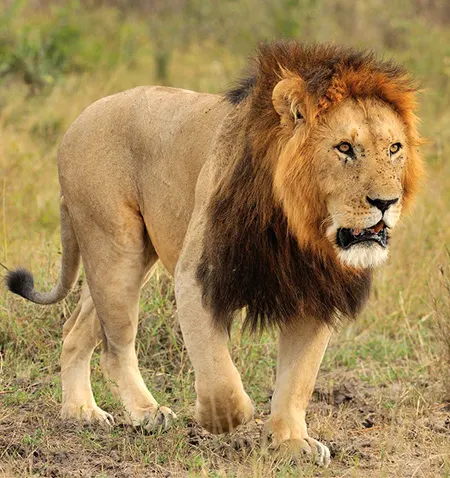
(Panthera leo)
Lion
Лев
It is found in scattered populations across sub-Saharan Africa, and a small population also exists in and around Gir National Park in Gujarat, western India. It prefers grassy plains and savannahs, scrub bordering rivers, and open woodlands with bushes. It occurs at elevations up to 3,600 m.

(Panthera onca)
Jaguar
Ягуар
It is found from southern Arizona and New Mexico south toward northern Argentina and north-eastern Brazil. It prefers dense forests and typically inhabits dry deciduous forests, tropical and subtropical moist broadleaf forests, rainforests and cloud forests at elevations up to 3,800 m.
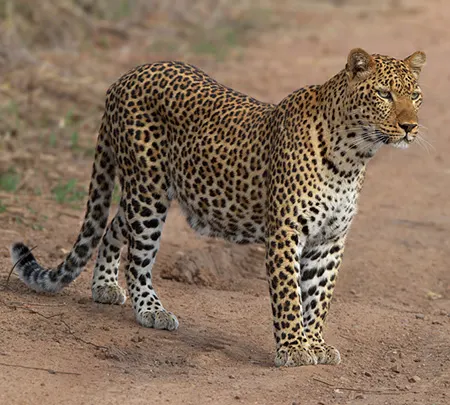
(Panthera pardus)
Leopard
Леопард
It is found in much of Africa (except the Sahara), Asia Minor, Transcaucasia, Pakistan, India, China, Indonesia, the islands of Java, and Sri Lanka. It inhabits savannas and rainforests, and areas where grasslands, woodlands, and riparian forests remain largely undisturbed.
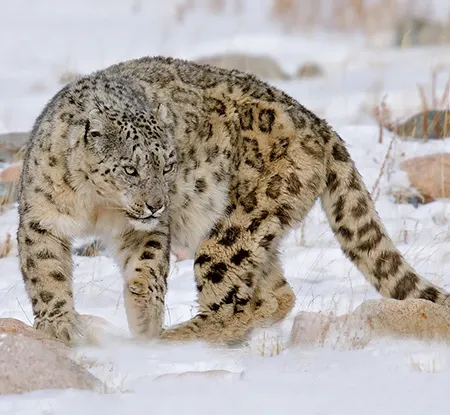
(Panthera uncia)
Snow leopard
Сніговий барс
It inhabits alpine and subalpine zones at elevations of 3,000–4,500 m, ranging from eastern Afghanistan, the Himalayas and the Tibetan Plateau to southern Siberia, Mongolia and western China. In the northern part of its range, it also lives at lower elevations.
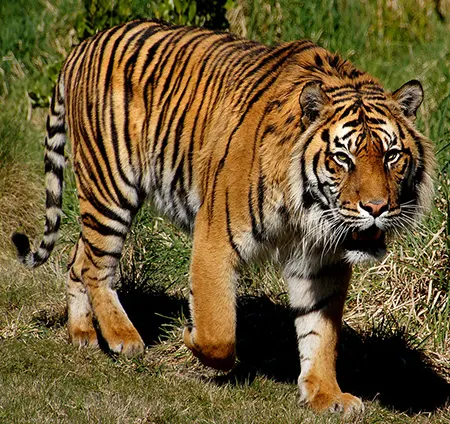
(Panthera tigris)
Tiger
Тигр
It inhabits mainly forests, from coniferous and temperate broadleaf and mixed forests in the Russian Far East and Northeast China to tropical and subtropical moist broadleaf forests on the Indian subcontinent and Southeast Asia.

(Neofelis nebulosa)
Clouded Leopard
Димчаста пантера
It occurs from the Himalayan foothills in Nepal, Bhutan and India to Myanmar, south-eastern Bangladesh, Thailand, Peninsular Malaysia and south of the Yangtze River in China.

(Neofelis diardi)
Sunda Clouded Leopard
Борнейська пантера
It is restricted to the islands of Borneo and Sumatra. In Borneo, it occurs in lowland rainforest, and at lower density in logged forest below 1,500 m. In Sumatra, it appears to be more abundant in hilly, montane areas.
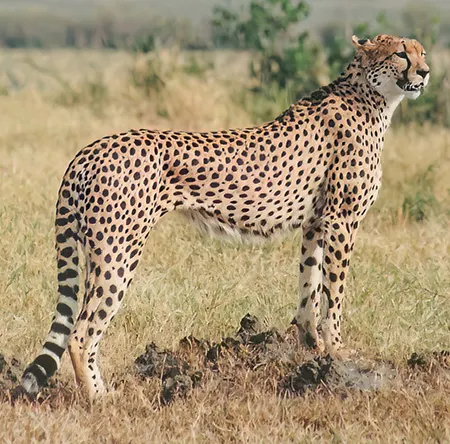
(Acinonyx jubatus)
Cheetah
Гепард
In eastern and southern Africa, the it occurs mostly in savannas. In central, northern and western Africa, it inhabits arid mountain ranges and valleys; in the harsh climate of the Sahara, it prefers high mountains. In Iran, it occurs in hilly terrain of deserts at elevations up to 2,000–3,000 m.

(Caracal caracal)
Caracal
Каракал звичайний
It lives in the savannas, deserts and foothills of Africa (except for the Sahara and equatorial jungles), in the deserts of the Arabian Peninsula, Asia Minor and Central Asia. It is found in the deserts of southern Turkmenistan, on the coast of the Caspian Sea it reaches the Mangyshlak Peninsula, in the east it sometimes appears in the Bukhara region of Uzbekistan. It is quite rare in north-western India.
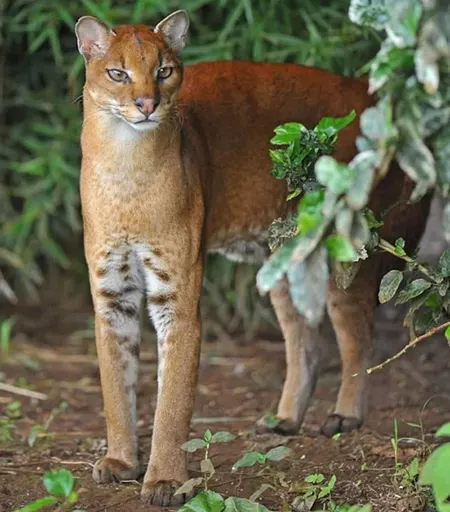
(Caracal aurata)
African Golden Cat
Каракал золотий
It is distributed from Senegal to the Central African Republic, Kenya and as far south as northern Angola. It inhabits tropical forests from sea level to an elevation of 3,000 m.
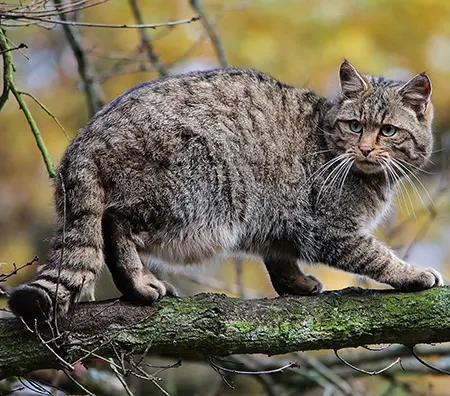
(Felis silvestris)
European Wildcat
Кіт лісовий
It is found in Central and Southern Europe, Asia Minor, and the Caucasus region. It lives in dense oak, oak-hornbeam, beech, and mixed forests, and rarely in spruce forests, at altitudes of 300–900 m.
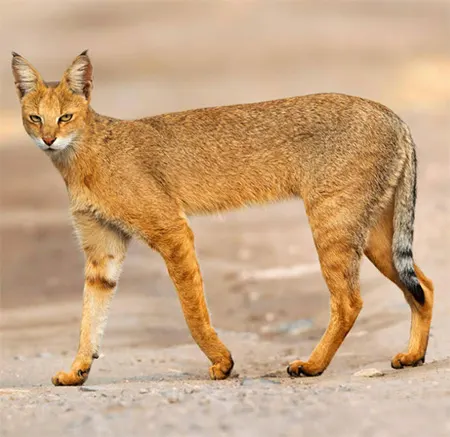
(Felis chaus)
Jungle cat
Кіт очеретяний
It is found in the Middle East, the Caucasus, the Indian subcontinent, central and Southeast Asia, Sri Lanka and in southern China. It inhabits places with adequate water and dense vegetation, such as swamps, wetlands, littoral and riparian areas, grasslands and shrub.
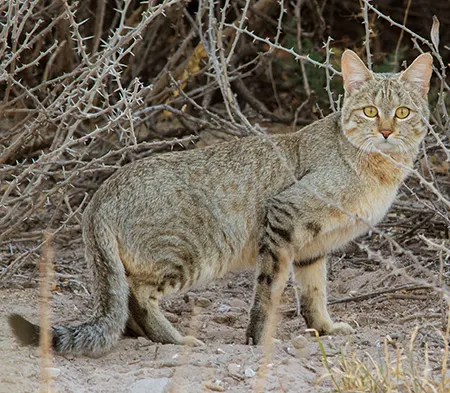
(Felis lybica)
African Wildcat
Кіт степовий
It occurs throughout Africa, as well as in the Middle East including parts of the Arabian Peninsula and most of Iran. Its range extends northeast into Central Asia, where it occurs along the eastern shores of the Caspian Sea, and through Kazakhstan to as far east as Xinjiang. It is also present in parts of India.
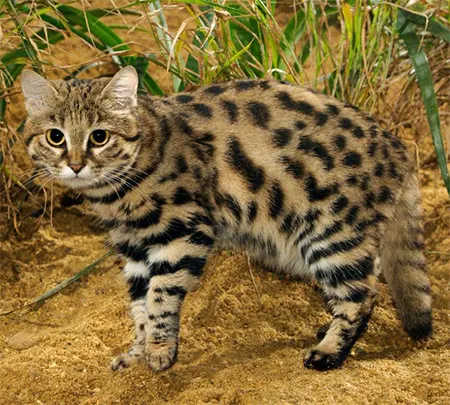
(Felis nigripes)
Black-footed Cat
Кіт чорноногий
It is endemic to Southern Africa. It inhabits open, arid savannas and semi-arid shrubland in the Karoo and the south-western Kalahari with short grasses, low bush cover, and scattered clumps of low bush and higher grasses.

(Felis margarita)
Sand Cat
Кіт барханний
It inhabits both sandy and stony deserts. It is widely but not contiguously distributed in the deserts of North Africa and Southwest and Central Asia.
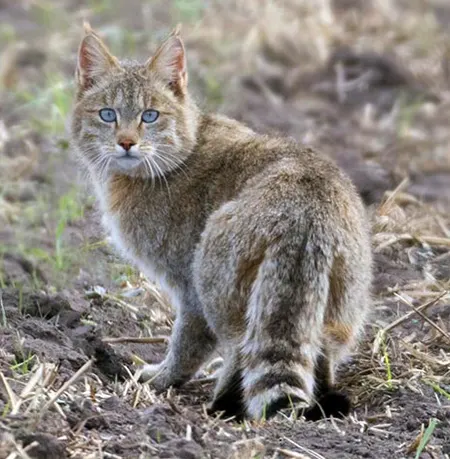
(Felis bieti)
Chinese Mountain Cat
Кіт китайський горний
It is endemic to China and lives on the north-eastern edge of the Tibetan Plateau. It was recorded only in eastern Qinghai and north-western Sichuan. It inhabits high-elevation steppe grassland, alpine meadow, alpine shrubland and coniferous forest edges at elevations of 2,500–5,000 m.
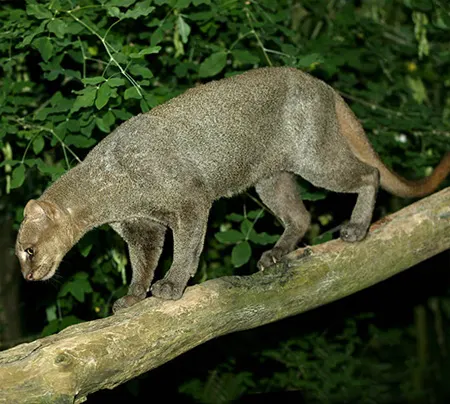
(Herpailurus yagouaroundi)
Jaguarundi
Ягуарунді
Its range extends from central Argentina in the south to northern Mexico, through Central and South America east of the Andes. It inhabits a broad array of both closed and open habitats ranging from tropical rainforests and deciduous forests to deserts and thorn scrubs.
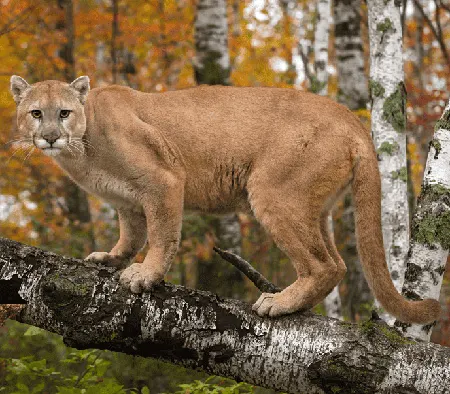
(Puma concolor)
Cougar
Пума
It inhabits North, Central, and South America, with a range that spans from Yukon, British Columbia, and Alberta in Canada to the Amazon Rainforest and the southern Andes Mountains of Patagonia. It prefers habitats with dense underbrush and rocky areas for stalking but also lives in open areas at elevations up to 4,000 m.

(Leptailurus serval)
Serval
Сервал
It is found throughout Africa but now predominantly resides in southern Africa, especially in Zimbabwe and the province of Natal. Small populations are located in the Atlas Mountains. It has also been found in Algeria, Morocco, Ethiopia, and south of the Sahara.
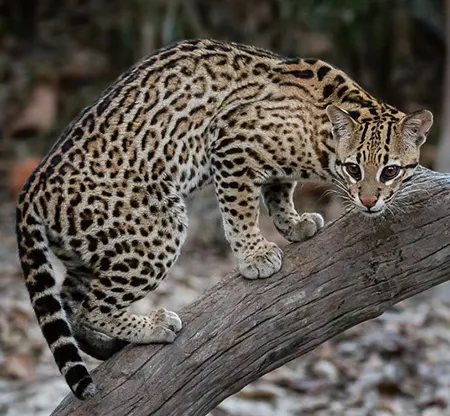
(Leopardus pardalis)
Ocelot
Оцелот
Its range extends from the south-western United States to northern Argentina, including the Caribbean islands of Trinidad and Margarita. It inhabits tropical forests, thorn forests, mangrove swamps and savannas up to an elevation of 3,000 m.

(Leopardus guigna)
Kodkod
Кодкод
It is found in central and southern Chile, and marginally in adjacent areas of Argentina. It inhabits mixed temperate rainforests of the southern Andean and coastal ranges at elevations of up to 2,000 m.

(Leopardus wiedii)
Margay
Леопард Віда
It is distributed from the tropical lowlands in Mexico through Central America to Brazil and Paraguay. It inhabits almost exclusively dense forests, ranging from tropical evergreen forest to tropical dry forest and high cloud forest at elevations of up to 1,200 m.
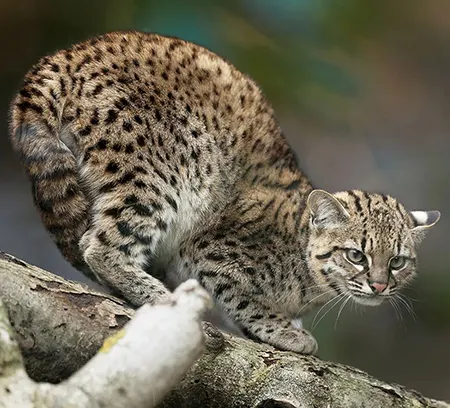
(Leopardus geoffroyi)
Geoffroy's Cat
Леопард Жоффруа
It is distributed in Argentina, Bolivia, Brazil, Chile, Paraguay and Uruguay. It inhabits pampas and savanna landscapes in the Gran Chaco from southern Bolivia to the Straits of Magellan ranging at elevations from sea level up to 3,800 m in the Andes.
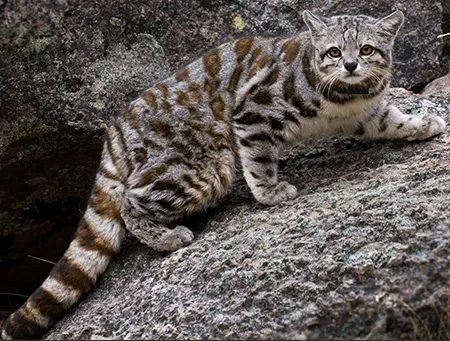
(Leopardus jacobita)
Andean Mountain Cat
Леопард андський
It lives only at high elevations in the Andes. Records in Argentina indicate that it lives at elevations from 1,800 m in the southern Andes to over 4,000 m in Chile, Bolivia and central Peru.
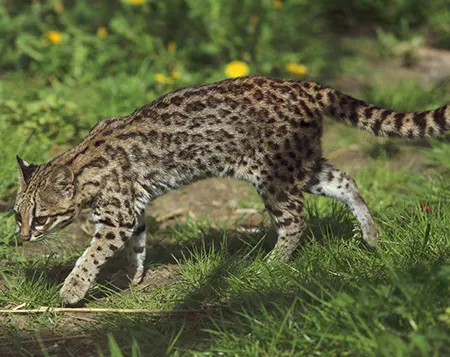
(Leopardus guttulus)
Southern Tigrina
Південна онцила
It occurs from central to southern Brazil in Minas Gerais and Goiás states, in the Atlantic forest, eastern Paraguay and north-eastern Argentina below elevations of 2,000 m.
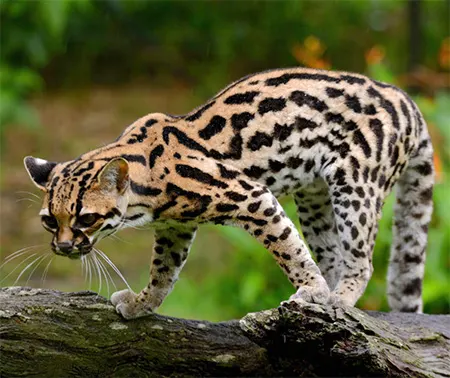
(Leopardus tigrinus)
Northern Tigrina
Північна онцила
It is distributed from a disjunct population in Costa Rica and Panama, and throughout the Amazon basin to central Brazil. It occurs at elevations up to 4,800 m.
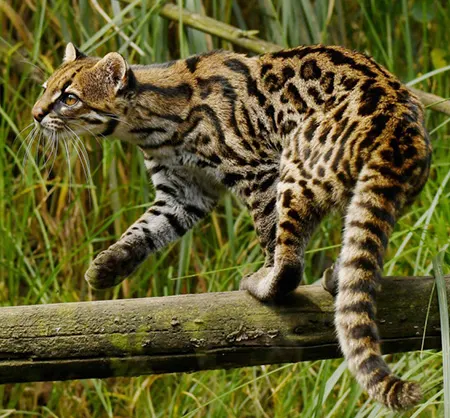
(Leopardus pardinoides)
Clouded Tiger-Cat
Хмарна тигрова кішка
It lives in high-altitude cloud forests of southern Central America and Andean mountains at elevations of up to 3,960 m.
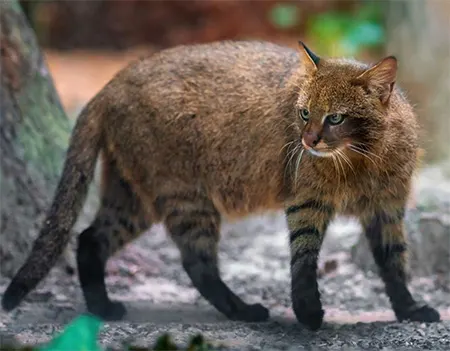
(Leopardus braccatus)
Pantanal Cat
Пантанальська кішка
It is found from sea level to 2,000 m in east-central Brazil, Uruguay, and neighboring regions of central South America, including Bolivia, Paraguay, and Argentina. Within this range, it inhabits diverse habitats, from open grasslands to dense forests and dry forests.
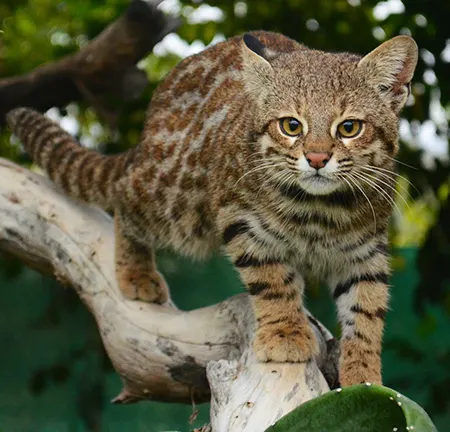
(Leopardus garleppi)
Garlepp's Pampas Cat
Пампасова кішка Гарлеппа
It lives in the Andes Mountains from Colombia to northwestern Argentina and northern Chile. It occurs at elevations of up to 4,800 m.
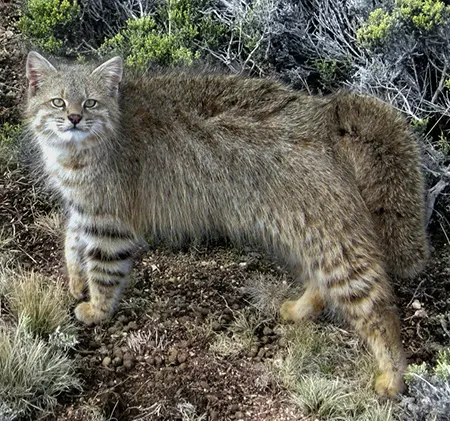
(Leopardus pajeros)
Southern Pampas Cat
Південна пампасова кішка
It inhabits the pampas grasslands of central and southern Argentina and Chile.

(Leopardus colocola)
Colocolo
Колоколо
It is found on the western slopes of the Andes at elevations of up to 1,800 m.
The genus (Leopardus) also includes: Uruguayan Pantanal Cat (Leopardus fasciatus)
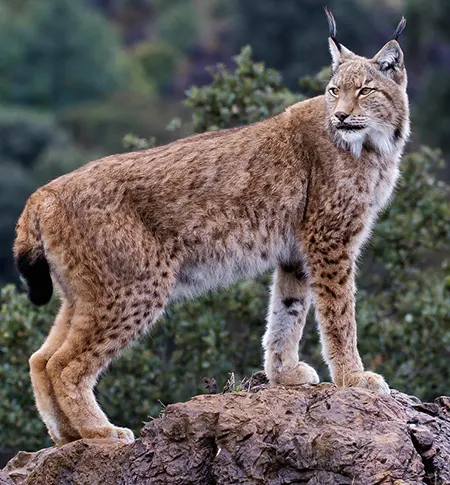
(Lynx lynx)
Eurasian Lynx
Рись євразійська
It is found in the mountain forests of the Carpathians, the Balkans, the Scandinavian Peninsula, the Polish Tatras, and parts of Spain, as well as in Siberia (Russia). Its range extends across forests from the Baltic Sea to the Pacific Ocean, and from near the Arctic Circle to the Caucasus, the Altai, the Sayan Mountains, and the Sikhote-Alin range.
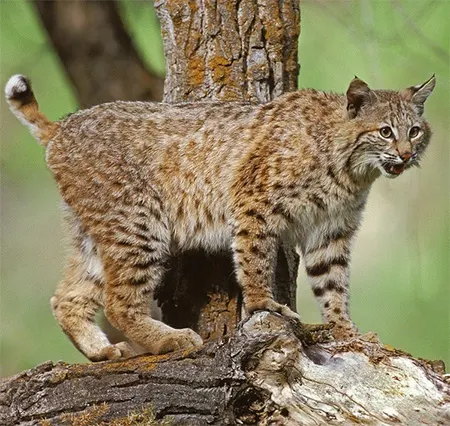
(Lynx rufus)
Bobcat
Рись руда
It is found from Canada to central Mexico and across the entire United States, from the east to the west coast. It inhabits forested areas, semi-deserts, and swamps.
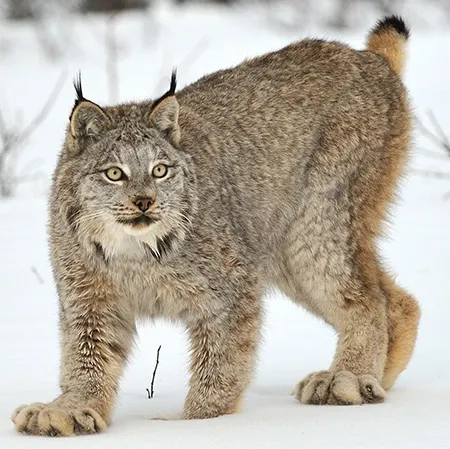
(Lynx canadensis)
Canada Lynx
Рись канадська
It ranges across Alaska, Canada and northern areas of the contiguous United States, where it predominantly inhabits dense boreal forests.
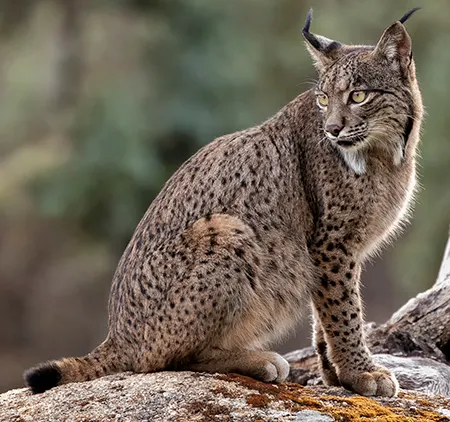
(Lynx pardinus)
Iberian Lynx
Рись іспанська
It is endemic to the Iberian Peninsula in southwestern Europe. It prefers heterogeneous environments of open grassland mixed with dense shrubs such as strawberry tree, mastic, and juniper, and trees such as holm oak and cork oak
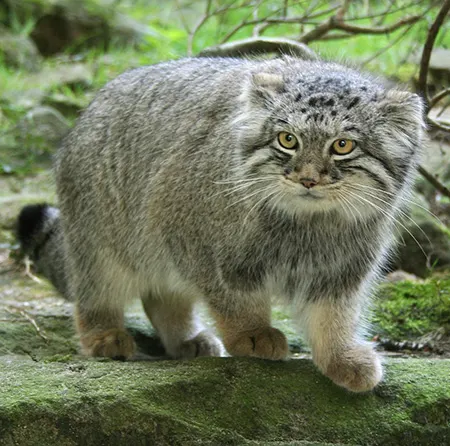
(Otocolobus manul)
Pallas's Cat
Манул
Its range extends from the Caucasus eastward to Central Asia, Mongolia, and adjacent parts of Dzungaria and the Tibetan Plateau. It inhabits montane shrublands and grasslands, as well as rocky outcrops, scree slopes, and ravines in areas where continuous snow cover remains below 15–20 cm.

(Pardofelis marmorata)
Marbled Cat
Мармурова кішка
It occurs along the eastern Himalayan foothills and in tropical Indomalaya, extending eastward into south-western China and onto the islands of Sumatra and Borneo. It is primarily associated with moist and mixed deciduous–evergreen tropical forests at elevations up to 2,500 m.

(Catopuma temminckii)
Asian Golden Cat
Катопума Темінка
It ranges from eastern Nepal, northeastern India and Bhutan to Bangladesh, Myanmar, Thailand, Cambodia, Laos, Vietnam, southern China, Malaysia and Sumatra. It prefers forest habitats interspersed with rocky areas and inhabits dry deciduous, subtropical evergreen and tropical rainforests.
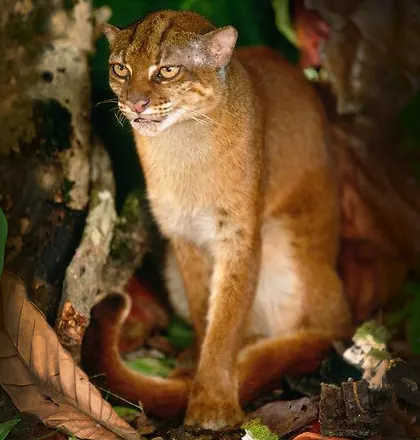
(Catopuma badia)
Bay Cat
Катопума калімантанська
It is found exclusively on the island of Borneo (Indonesia). It inhabits forested areas on plains and hills, as well as swampy regions, at elevations up to 800 m.
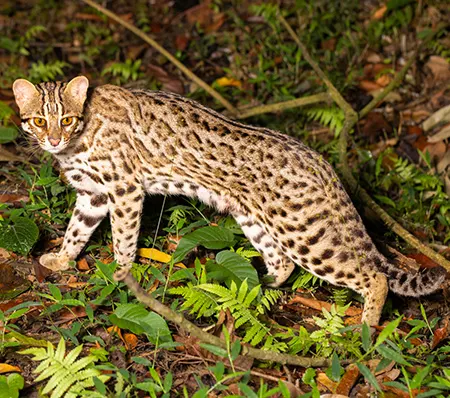
(Prionailurus bengalensis)
Leopard Cat
Бенгальський кіт
Its range extends from the Amur region in the Russian Far East over the Korean Peninsula, China, Indochina, the Indian Subcontinent to northern Pakistan. It lives in tropical evergreen rainforests and plantations at sea level, in subtropical deciduous and coniferous forests in the foothills of the Himalayas at elevations above 1,000 m.
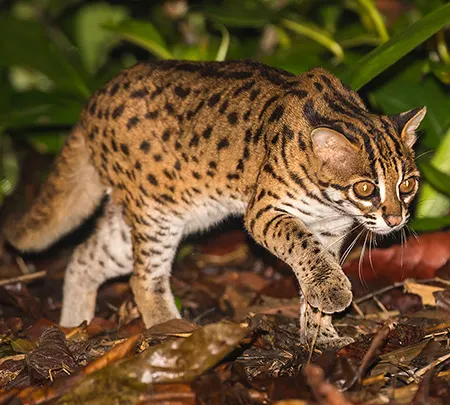
(Prionailurus javanensis)
Sunda Leopard Cat
Сундська леопардова кішка
It inhabits the islands of Sumatra, Borneo, Java, Bali, Tebingtinggi, Palawan, Negros, Cebu and Panay. Its natural habitat is lowland tropical evergreen forest.
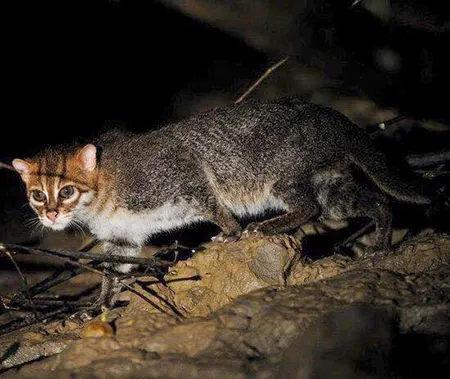
(Prionailurus planiceps)
Flat-headed Cat
Плоскоголовий кіт
Its distribution is restricted to lowland tropical rainforests in extreme southern Thailand, Peninsular Malaysia, Sumatra and Borneo. It primarily inhabits freshwater habitats near coastal and lowland areas.
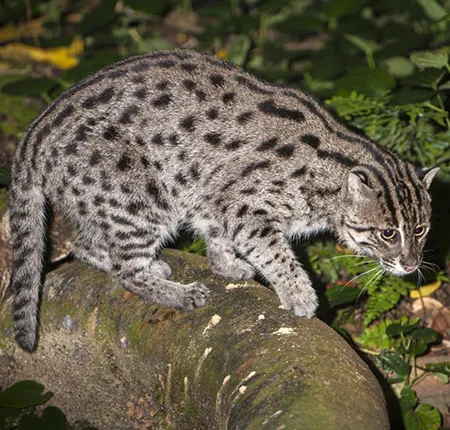
(Prionailurus viverrinus)
Fishing Cat
Кіт-рибалка
It lives in the tropical and subtropical regions of Southeast Asia, including the Himalayan foothills of India and Nepal, eastern India, Bangladesh, and the island of Sri Lanka.
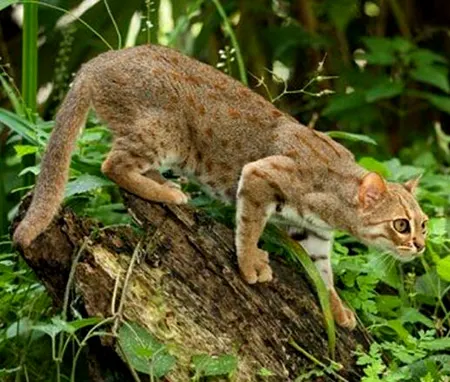
(Prionailurus rubiginosus)
Rusty-spotted Cat
Плямисто-рудий кіт
It is found in India, the western Terai of Nepal, and Sri Lanka. It occurs mainly in moist and dry deciduous forests as well as scrub and grassland, at elevations up to 2,100 m.
